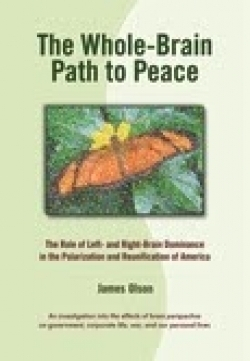
The Whole-Brain Path to Peace
The Role of Left- and Right-Brain Dominance in the Polarization and Reunification of America
- 2011 INDIES Winner
- Gold, Philosophy (Adult Nonfiction)
- 2011 INDIES Finalist
- Finalist, Self-Help (Adult Nonfiction)
Research on the different functions dictated by the left or right side of the brain has been abundant, particularly in the last decade as those in neuroanatomy and neuroscience work to map the nervous system and the human brain. But often lacking in the science of brain lateralization is a sense of how we, as beings, are affected by what’s happening in each hemisphere.
First-time author James Olson dives deep into interdisciplinary studies in order to bring fresh perspective to the issue. Drawing on philosophy, science, theology, sociology, political science, and anthropology, Olson expertly culls insight from each discipline in order to create intriguing theories about how the brain can distort our perceptions and drive our actions based on which hemisphere is more dominant.
His interest isn’t merely academic; he believes that understanding the brain more fully can lead to personal and cultural transformation and lead to peace on both an individual and global scale. “Peace, like everything else, is an energy, and the two brain hemispheres process energy in radically different ways (one unifies, one separates),” he writes. People tend to direct energy toward either peace or conflict, and this push toward one or the other depends on which brain hemisphere is dominant, Olson notes.
For example, he posits, political conservatives tend to have left-brain values, which concern individual rights and responsibilities, whereas liberals lean toward right-brain values, which tap into collective needs and teamwork. Olson doesn’t claim that one side or the other is “good,” merely that their differences lead to polarization within groups.
The dualistic perspective of the left brain, for instance, separates everything that comes into its view, leading to clashes about political affiliation, abortion, homosexuality, and other hot button issues. Although the right brain can see both perspectives, there are many factors that can keep it from producing clear and accurate perceptions of the same issues.
In putting together his theories, Olson turns often to works of spiritual insight, which he calls “modern revelation,” and notes that his thought was heavily influenced by works like The Urantia Book and A Course in Miracles. These books, along with Eastern and Western philosophy, provide a framework in which Olson creates a unique perspective. He writes, “[T]he more mundane perspective of science is given added dimensionality with the addition of a fully elaborated spirit-based perspective.”
For those looking to understand the brain in a radically different way, Olson offers a multi-disciplinary view that’s intriguing. His ability to articulate how brain dominance affects issues like corporate motivation and government action proves compelling, and creates a guide on how to achieve personal transformation as well as peace on a larger scale.
Reviewed by
Elizabeth Millard
Disclosure: This article is not an endorsement, but a review. The publisher of this book provided free copies of the book and paid a small fee to have their book reviewed by a professional reviewer. Foreword Reviews and Clarion Reviews make no guarantee that the publisher will receive a positive review. Foreword Magazine, Inc. is disclosing this in accordance with the Federal Trade Commission’s 16 CFR, Part 255.
